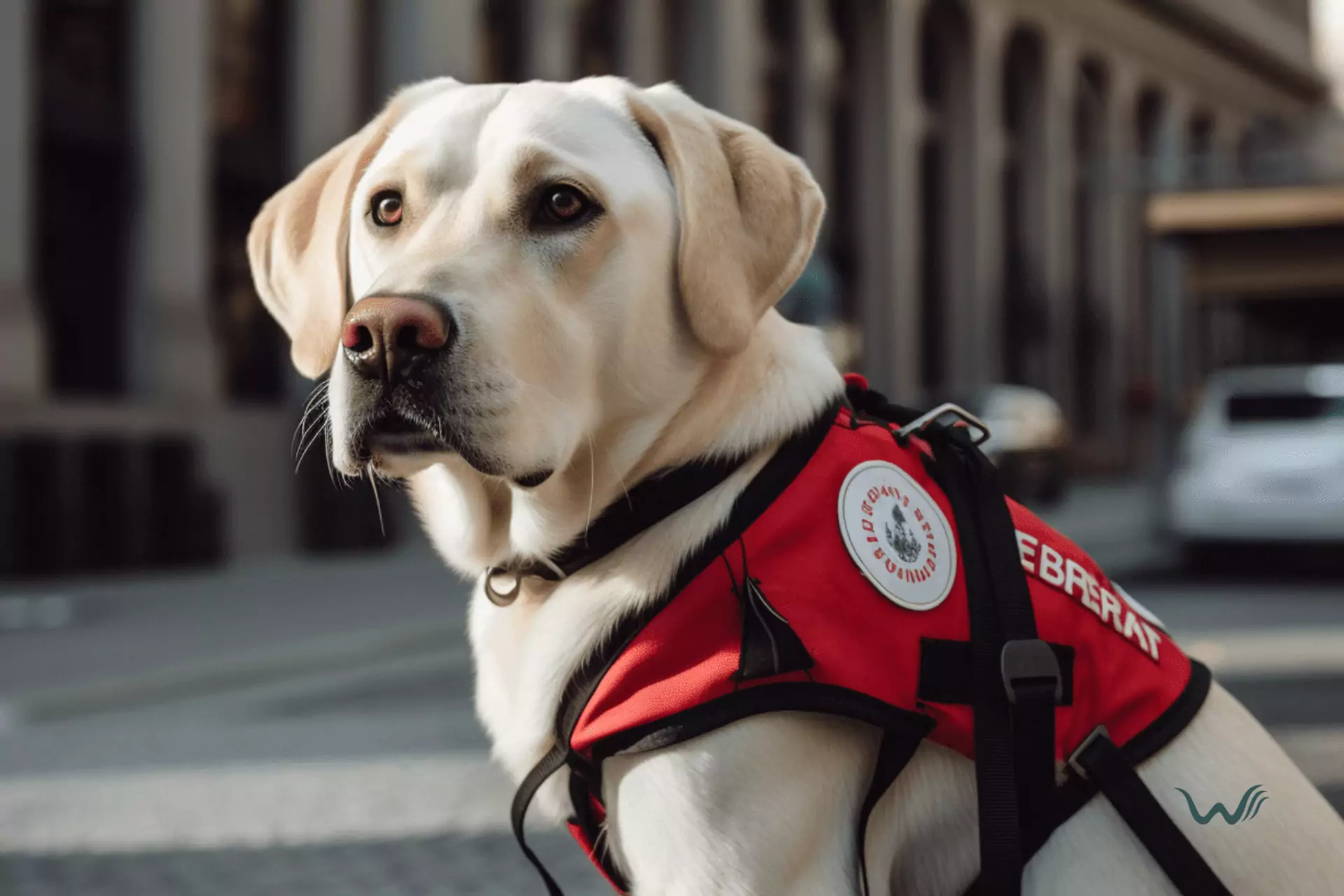

The Differences Between A Real And Fake Service Dog Vest
by Haley Mills
Last updated: June 20, 2025
Verified and Approved by:
Angela Morris,
MSW, LCSW
Fact Checked

Service dogs play a crucial role in the lives of individuals with disabilities, providing them with support, assistance, and increased independence. These highly trained animals are protected by laws that grant them access to public spaces, transportation, and housing.
Where Can Service Dogs Go?
Service dogs can accompany their handlers to nearly any location the public is allowed. This includes:
- Public Accommodations: Restaurants, stores, government buildings, and medical facilities welcome service dogs.
- Transportation: They are allowed on public transit systems, including buses and trains, enhancing mobility for their handlers.
- Recreational Areas: Parks and other public spaces are also accessible to service dogs.
Additionally, service dogs are entitled to live with their handlers in most rental housing situations, such as multifamily homes, condominiums, and apartment complexes, even if these places typically have no-pet policies.
Thanks to the Air Carrier Access Act (ACAA), service dogs can accompany their handlers during air travel, ensuring that individuals with disabilities can fly without restrictions.
By bridging these diverse environments, service dogs significantly enhance the quality of life for their handlers, empowering them to navigate the world with greater ease and confidence.
To help identify legitimate service dogs, specially designed vests are often worn, indicating their training and purpose. However, the rise of fake service dogs has become a prevalent issue, undermining the rights of genuine service dog handlers.
In this article, we will explore the differences between a real and fake service dog vest, highlighting the importance of distinguishing between the two to protect the rights of those who rely on these remarkable animals.
Identifying a genuine service dog vest is essential to ensure the integrity of the service dog community. Genuine service dog vests are typically made of high-quality materials, designed to withstand the demands of daily use. They often feature clear and visible labels or patches that indicate the dog’s role as a service animal. These vests are also equipped with sturdy and secure fastenings, ensuring they stay in place during the dog’s work and activities.
By understanding the characteristics of a real service dog vest, individuals can help prevent the misrepresentation of service dogs and safeguard the rights of those who depend on them.
Key Takeaways
- Genuine service dog vests are made of high-quality materials and have clear and visible markings indicating the dog is a service animal.
- Authentic vests indicate that the dog has undergone extensive training to assist individuals with disabilities.
- Fake service dog vests lack proper identification patches, undermining genuine service dogs’ legitimacy.
- Misrepresenting a service dog can lead to legal consequences, such as fines or imprisonment, and advocating for the rights of legitimate service dog handlers is important to protect their privileges and access to public spaces.
Understanding Emotional Support Animals vs. Service Dogs
Emotional support animals (ESAs) and service dogs serve distinct purposes, though both provide essential assistance to individuals with different needs. Understanding the differences between the two is crucial in ensuring they are appropriately utilized and respected.
Purpose and Functionality
- Emotional Support Animals: These animals primarily provide comfort and companionship to individuals dealing with emotional and psychological challenges such as anxiety, depression, or insomnia. They are not trained to perform specific tasks but instead offer a soothing presence that can alleviate symptoms of mental health issues.
- Service Dogs: On the other hand, service dogs undergo rigorous training to perform specific tasks for individuals with disabilities. This might include guiding a visually impaired person, alerting someone with a hearing impairment, or detecting oncoming seizures. Their tasks are directly linked to the individual’s disability and are critical to the person’s independence and safety.
Legal Protections and Access
- Access Rights: Service dogs are granted broad access rights under the Americans with Disabilities Act (ADA). This means they can accompany their owners into nearly all public spaces, including restaurants, stores, and public transportation.
- Emotional Support Animals: ESAs do not have the same legal standing as service dogs. While they are allowed in housing through the Fair Housing Act, access to other public spaces is more restricted. Some states and local governments may permit ESAs in certain areas, but this typically requires documentation, such as an ESA letter from a licensed mental health professional.
Species Variety
- Service Dogs: Generally, service animals are limited to dogs, and in rare cases, miniature horses.
- Emotional Support Animals: ESAs have a wider range of species options. Besides dogs, they can include cats, rabbits, and even birds like parrots, allowing individuals to choose an animal that best fits their personal needs and living situations.
In summary, while both emotional support animals and service dogs provide invaluable assistance to their humans, they differ significantly in their training, the roles they perform, and the legal rights they possess. Understanding these differences is essential for recognizing and respecting the roles they play in their owners’ lives.
Identifying a Genuine Service Dog Vest
A genuine service dog vest serves a crucial purpose in society by allowing individuals with disabilities to have the support and assistance they need. These vests are not just a fashion statement or an accessory; they signify that the dog wearing it has undergone extensive training and meets the requirements to be a service dog.
One way to identify a genuine service dog vest is to look for specific features. Authentic vests often have clear and visible markings that indicate the dog is a service animal. These markings may include patches or badges on a harness that state “Service Dog” or “Do Not Pet.” Genuine service dog vests are typically made of durable, durable materials that can withstand the rigors of daily use. They are designed to be comfortable for the dog and allow easy movement while clearly identifying the dog as a service animal.
Another aspect to consider when identifying a genuine service dog vest is the training requirements for service dogs. Service dogs undergo extensive training to ensure they can perform tasks that mitigate the effects of a person’s disability. The training process involves teaching the dog specific commands and skills to assist their handler in their daily activities. These skills can range from opening doors and retrieving items to providing emotional support during times of distress.
Examples of Service Dog Tasks:
- Medication Reminders: Some service dogs are trained to remind their owner with depression to take their medication, ensuring they maintain their treatment regimen.
- Health Alerts: For individuals with diabetes, a service dog might be trained to alert them when their blood sugar levels drop, providing a critical health safeguard.
- Assistance with Mobility: Dogs may retrieve items for handlers who are unable to do so due to physical limitations, enhancing their independence.
By mastering these diverse tasks, service dogs become indispensable companions, offering both practical assistance and emotional support to their handlers.
A genuine service dog vest indicates that the dog wearing it has completed this rigorous training and is capable of providing the necessary support to individuals with disabilities.
What Are the Different Types of Service Dogs?
When we think about service dogs, we often envision them assisting individuals with physical disabilities. However, these amazing animals serve in many capacities, providing essential support to those with both visible and invisible conditions. Let’s dive into the main types of service dogs and the unique roles they play.
Psychiatric Service Dogs
For individuals grappling with mental health challenges, psychiatric service dogs are a lifeline. These specially trained dogs are more than just comforting companions; they perform tasks tailored to their owner’s mental health needs. For instance, they might recognize the signs of a panic attack and intervene to alleviate the symptoms, helping to provide stability and reassurance in moments of distress.
Service Dogs for Physical Disabilities
Service dogs that assist people with physical disabilities are perhaps the most recognizable. From guiding individuals with vision impairments to retrieving items for someone with mobility challenges, these dogs are trained to meet specific needs. In cases of conditions like epilepsy, they may even alert their owner to an impending seizure or ensure their safety during an episode.
Additional Types of Service Dogs
- Medical Alert Dogs: These dogs are adept at detecting physiological changes that could signal a medical crisis, such as a drop in blood sugar for a person with diabetes or an upcoming migraine.
- Hearing Dogs: They assist those who are deaf or hard of hearing by alerting them to important sounds like doorbells, alarms, and even someone calling their name.
- Guide Dogs: Primarily known for helping visually impaired individuals navigate their surroundings, guide dogs are trained to lead their owners around obstacles safely and effectively.
In summary, service dogs are essential partners tailored to the unique needs of their owners, making life more manageable for many individuals facing daily challenges. Whether offering physical support, ensuring safety during a health crisis, or helping manage emotional well-being, these loyal and skilled animals are indispensable in a myriad of ways.
How to Acquire a True Service Dog
If you need a genuine service dog, the first step is connecting with a trusted organization that specializes in training service animals. Here’s a closer look at how the process works:
Obtain a Diagnosis for a Disability
To qualify for a service dog, you must have a documented disability that requires support from a trained animal. This is a crucial first step, as it ensures the dog will be trained to perform specific tasks that directly meet your needs.
Choose Between Professional Training or DIY Training
There are two main ways to train a service dog:
- Professional Training: Partnering with an experienced trainer or organization ensures your dog receives specialized, structured training. These professionals are skilled in preparing dogs to handle a wide range of responsibilities—from guiding individuals with visual impairments to alerting someone during a seizure. Reputable programs often follow tested protocols and can offer continued support throughout the dog’s working life.
- Self-Training: If you’re confident in your ability and have the time, you can train the dog yourself. This option gives you the freedom to customize the training to suit your specific disability. However, it demands patience, consistency, and a solid understanding of dog behavior and positive reinforcement methods.
Whether you choose to train the dog yourself or work with a professional, both paths require dedication and a clear understanding of your legal responsibilities as a service dog handler.
By following these steps, you can obtain a legitimate service dog trained to improve your independence and quality of life.
Common Signs of a Fake Service Dog Vest
One telltale sign of a phony service dog vest is the lack of proper identification patches. Genuine service dog vests typically have clear and visible patches that indicate the dog’s role as a service animal. These patches often include phrases such as “Service Dog” or “Working Dog” and may also include the name or logo of the organization that trained the dog.
These identification patches are essential for several reasons. Firstly, they help to inform the public that the dog is a trained service animal and should be given appropriate accommodations. Secondly, they ensure that the dog is easily identifiable as a service animal, which can be crucial in situations where the dog needs to be recognized as such, such as in stores or on public transportation.
Using a fake service dog vest not only raises ethical concerns but also significantly impacts the public perception of service dogs. When individuals falsely claim their pets as service animals by using counterfeit vests, it undermines the legitimacy and importance of genuine service dogs. This can lead to skepticism and doubt among the general public, making it more difficult for individuals with legitimate service dogs to access the rights and accommodations they need. If you don’t have a legit service dog, you should take the steps to make that so and maybe for now just purchase a sturdy collar or harness until it’s official.
Moreover, it can create confusion and potential safety risks in public spaces, as individuals may be unable to distinguish between a trained service dog and an untrained pet. Therefore, it is crucial to address the issue of fake service dog vests to ensure the integrity of the service dog system and protect the rights of those who genuinely rely on these animals for assistance.
Legal Consequences of Misrepresenting a Service Dog
Misrepresenting a service dog can result in legal consequences, such as fines or even imprisonment. It’s important to understand that service dogs are not just pets; they’re highly trained animals that assist individuals with disabilities. Misrepresenting a dog as a service dog when it’s not can have serious implications.
One of the main consequences of misrepresentation is the potential for fines. Many states have laws that make misrepresenting a pet as a service dog illegal. These laws typically carry fines ranging from a few hundred dollars to several thousand dollars. In addition to fines, individuals caught misrepresenting a service dog may also face other legal penalties, such as community service or probation.
In some cases, misrepresenting a service dog can even lead to imprisonment. While this is less common, there have been instances where individuals have been charged with criminal offenses for falsely claiming their pet as a service dog. These cases typically involve instances where the misrepresentation has caused harm or posed a danger to others.
State-Specific Legislation
Various states have enacted laws to combat the fraudulent representation of service animals. For instance, Arkansas HB1420 mandates that businesses selling emotional service animals or related products must provide written notice clarifying that an ESA is not recognized as a service animal under the Americans with Disabilities Act (ADA). Additionally, they must inform customers that items such as vests, harnesses, or registrations are not necessary for having a service dog or ESA.
In California, <Law AB468 stipulates added requirements for licensed mental health professionals (LMHP) who issue ESA or service dog letters. Before writing such a letter, the LMHP must have an active relationship with the patient for at least 30 days and hold a valid license to practice mental health in the state.
Protecting the Rights of Individuals with Disabilities
Misrepresenting a service dog not only has legal consequences, but also undermines the rights of individuals with disabilities who rely on their service dogs for assistance. By falsely claiming a pet as a service dog, individuals are taking away resources and accommodations that are specifically designed to assist those who need them.
Stay Informed
As you navigate the process, it’s always wise to familiarize yourself with the specific laws in your state to avoid falling for fraudulent services or inadvertently breaking the law. This vigilance helps protect both the integrity of service dog programs and the individuals who genuinely rely on them.
Protecting the Rights of Legitimate Service Dog Handlers
Advocating for the rights of legitimate service dog handlers involves ensuring the protection of their privileges and supporting their access to public spaces. Service dog handlers often face numerous challenges when navigating public spaces. One of the main challenges is the lack of understanding and awareness about the rights and responsibilities of service dog handlers.
Many people are unaware that service dogs are allowed in public spaces and may discriminate against handlers by denying them access or questioning the legitimacy of their service dog. Another challenge service dog handlers face is the presence of fake service dogs. These are dogs that are not properly trained or certified as service dogs, but are dressed in fake service dog vests to gain access to public spaces.
Fake service dogs can cause disruptions and create issues for legitimate service dog handlers. This is why proper training for service dogs is crucial. A well-trained service dog can perform specific tasks to assist their handler and behave appropriately in public settings. Proper training ensures that service dogs can navigate public spaces without causing disturbances or endangering the safety of others.
It also helps to differentiate between legitimate service dogs and fake ones. Service dog handlers work hard to train their dogs to perform tasks that mitigate their disabilities and improve their quality of life. By advocating for the rights of legitimate service dog handlers and promoting proper training, we can create a more inclusive and accommodating society for individuals with disabilities.
How Can I Tell If a Service Dog Vest Is Genuine or Fake?
When living with a service dog, it is important to ensure their vest is genuine. Look for official logos and certifications from service dog organizations. Check the material and craftsmanship for quality. Real service dog vests are designed to clearly identify the dog as a working animal, not a pet.
Understanding Service Dogs Under the ADA
According to the Americans with Disabilities Act (ADA), service dogs play a unique and vital role: they are trained to assist individuals with disabilities by performing specific tasks. These canines are more than pets; they are working animals with specialized training tied directly to their owner’s needs.
Key Characteristics of Service Dogs
- Individually Trained Tasks: Each service dog receives specialized training tailored to assist with tasks directly associated with their handler’s disability.
- Disability Support: Their tasks support a variety of disabilities, including psychiatric, sensory, mental, and intellectual challenges.
To qualify for having a service dog, two main criteria must be met:
- The individual must have a disability that necessitates the assistance of a dog.
- The dog must be specifically trained to execute work or tasks connected to that disability.
What Questions Can You Legally Ask About a Service Dog?
If you’re unsure whether a dog is a legitimate service animal, the Americans with Disabilities Act (ADA) only allows two questions:
- Is this dog required because of a disability?
- What specific tasks has this dog been trained to perform?
You cannot ask for documentation, details about the person’s disability, or demand that the dog demonstrate its tasks. These legal boundaries are in place to protect individuals with disabilities while still allowing reasonable confirmation when needed. Staying within these limits ensures compliance with federal law and supports the ethical treatment of service dog handlers.
Diverse Roles of Service Dogs
Service dogs are not one-size-fits-all. Instead, they are trained to excel in roles as diverse as those they serve, ensuring each handler receives the help they need to navigate their world more effectively.
Is a Vest Necessary for a Service Dog or Emotional Support Animal?
While a vest isn’t a legal necessity for service dogs or emotional support animals (ESAs), it often serves as a helpful tool. Here’s why:
- Public Awareness: Dressing your service dog or ESA in a vest can signal to others that your pet is more than a companion—it’s a working animal. This can help minimize distractions and interruptions, as people are more likely to respect an animal clearly marked as serving a purpose.
- Owner Convenience: While not required by law, a vest can simplify interactions in public spaces. It reduces the need for explanations and helps prevent misunderstandings, making outings more manageable for the handler.
- Varied Preferences: Some handlers might prefer using vests, while others find them unnecessary. The decision ultimately rests with the owner, considering personal preferences and lifestyle needs.
In conclusion, a vest is not mandatory for service dogs or ESAs, but it can offer practical benefits in public settings.
Are Service Dogs Required by Law to Wear a Vest?
No, service dogs are not mandated by law to wear a vest. While it might seem like a practical way to identify them, there is no legal requirement for service dogs, or Emotional Support Animals (ESAs), to don special attire or ID tags.
Understanding the Benefits
Although not legally required, a vest can serve a useful purpose. It can signal to the public that the animal is on duty, potentially reducing unwanted interactions. For many owners, this can make navigating public spaces smoother and more stress-free.
What the Law Says
The Americans with Disabilities Act (ADA) supports this by stating that service dogs do not need to have any form of identification. The key factor is the dog’s training to assist someone with a disability, not whether the animal wears identifiable gear.
Making Your Decision
Choosing whether or not to outfit your service dog with a vest rests entirely with you. Consider your specific needs and circumstances to make the most informed decision.
Can Anyone Buy a Service Dog Vest?
Absolutely, service dog vests are available for purchase by anyone. There is no legal requirement for a service dog to wear a vest, nor is there an official body that regulates or certifies these purchases. This means anyone can order a vest, regardless of their need or the abilities of their dog.
However, it’s crucial to note that these vests should ideally be used by individuals whose dogs are genuine service animals or emotional support animals (ESAs). The presence of a vest does not automatically grant any dog legal service animal status, and misuse can have legal implications and ethical considerations. For those requiring these services, it’s important to respect the intended use of service dog vests and ensure they are used appropriately.
Tips for Reporting Suspected Fake Service Dogs
If you suspect a fake service dog, here are some tips for reporting it. It is important to remember that misrepresenting a pet as a service animal is unethical and undermines the rights of individuals who genuinely rely on service dogs for assistance.
One of the first things you can do is to document any suspicious behavior or signs that the dog may not be a legitimate service animal. This could include observing the dog’s behavior, noting if it’s disruptive or poorly trained, or if the owner can’t control it. Additionally, you can note any inconsistencies in the dog’s appearance, such as a lack of proper identification or a service dog vest that doesn’t seem authentic.
When reporting a suspected fake service dog, providing clear and detailed information to the appropriate authorities is essential. This can include contacting local law enforcement or the organization certifying legitimate service animals in your area. Be prepared to provide evidence, such as photographs or videos, to support your claim.
Penalties for Misrepresenting a Service Dog
Across the U.S., fake service dog laws are tightening. Currently, 23 states have legislation penalizing individuals who misrepresent pets as service animals. These offenses are often treated as misdemeanors and can result in fines or even jail time. For example:
- Arizona imposes a $250 fine for fraudulent representation.
- California penalties can reach $1,000 and six months in jail.
Businesses aren’t exempt either. In Arkansas, sellers of emotional support animal products must disclose that ESAs are not recognized as service animals under the Americans with Disabilities Act (ADA), and items like vests or registration are not legally required.
California’s AB468 adds further regulation: licensed mental health professionals must have an existing relationship with a patient (minimum 30 days) before writing an ESA or service dog letter, and must be licensed to practice within the state.
Understanding these laws helps prevent fraud and protects the rights of individuals with legitimate service dogs.
How Do Psychiatric Service Dogs Differ from Emotional Support Animals (ESAs)?
When it comes to support animals, it’s essential to understand the distinction between psychiatric service dogs and emotional support animals (ESAs). Both play pivotal roles in enhancing the quality of life for those with mental health challenges, but they do so in quite different ways.
Legal Classification and Training
Psychiatric Service Dogs: These dogs are recognized as service animals under the Americans with Disabilities Act (ADA). They undergo rigorous training to perform specific tasks tailored to aid individuals with psychiatric disabilities. For example, they might remind their owner to take medication, interrupt self-harming behaviors, or provide physical space in crowded situations.
Emotional Support Animals (ESAs): ESAs do not require specialized training to perform tasks. Instead, their primary function is to offer comfort and emotional stability through companionship. While helpful in alleviating symptoms of emotional conditions, they are not considered service animals under the ADA.
Access to Public Spaces
Service dogs have broad public access rights, allowing them to accompany their handlers into most places where the general public is permitted, such as restaurants, stores, and public transportation.
ESAs have more restricted access. While some locations may grant entry to emotional support animals with an appropriate ESA letter from a mental health professional, they do not inherently have the same access rights as service dogs. Although the federal law does not grant ESAs the same public access privileges, some states and local governments may allow ESAs into certain public spaces if you have valid documentation. However, these exceptions are limited and often vary by region, so it’s important to check local regulations before expecting ESA access in public venues.
Animal Types and Responsibilities
Service dogs are typically limited to dogs due to the need for specific training and behavioral predictability.
ESAs can be a variety of animals, including cats, birds, and more, without needing to perform individualized tasks.
Understanding these differences can help individuals determine which type of support animal is most suitable for their needs, ensuring they comply with legal standards while receiving the crucial emotional or functional assistance they require.
Frequently Asked Questions
How do I differentiate between a genuine service dog vest and a fake one based on the material used?
Differentiating between genuine and fake service dog vests based on material can be challenging. However, genuine vests are typically made with high-quality, durable materials that ensure longevity. Proper identification is crucial for service dogs; using a fake vest can pose risks and legal consequences.
Are any specific markings or logos typically found on a genuine service dog vest?
There are typically specific markings or logos found on genuine service dog vests, such as the organization’s logo or a Service Dog patch, badge, or tag.
Is a fake service dog vest possible to look identical to a genuine one?
A fake service dog vest can look identical to a genuine one. However, proper identification is crucial for service dogs as it ensures they have met the necessary training requirements to assist their handlers.
Can a fake service dog vest be easily identified by observing the dog’s behavior?
Observing the behavior of a dog wearing a fake service dog vest may provide some clues, but it is not a foolproof method. Genuine service dogs undergo extensive training, while fake ones lack proper training. This poses accessibility issues for individuals with legitimate disabilities.
Are there any legal consequences for individuals knowingly purchasing or using a fake service dog vest?
Knowingly purchasing or using a fake service dog vest can have legal consequences, as it is considered fraud in many jurisdictions. Additionally, it has ethical implications, as it undermines the rights and access of individuals with legitimate service dogs.
Certify Your Emotional Support Animal Today

Why You Can Rely on Us?
At Wellness Wag, we believe your pet deserves care rooted in both science and compassion. Each article is carefully researched, written in clear language for pet owners, and then reviewed by qualified professionals to ensure the information is evidence-based, current, and practical for real-life care. Our goal is to help you feel confident in making informed decisions about your pet’s health and well-being.
Reviewed by
Angela Morris, MSW, LCSW
Angela is a licensed clinical social worker with 20 years of experience in patient advocacy and community mental health. She has assisted numerous clients with ESA evaluations and brings a deep understanding of disability accommodations, ensuring that all information is accurate, supportive, and practical.

Written by :
Haley Mills
Last Updated :
June 20, 2025










